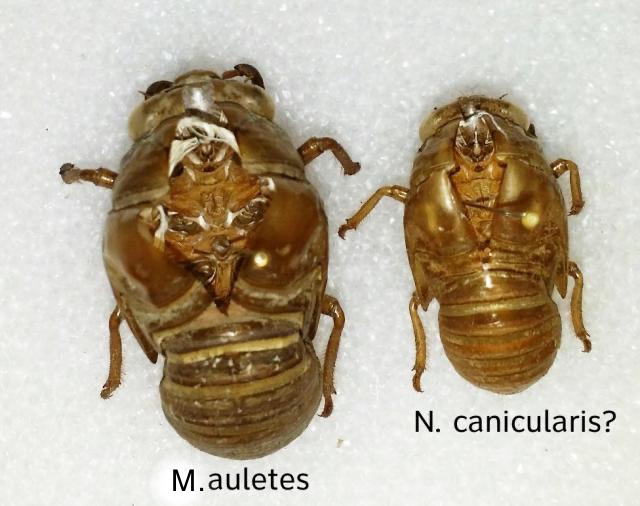
A photo of a Megatibicen auletes compared to a smaller Neotibicen exuvia (I believe it is an N. canicularis based on the time of year and location (mid-New Jersey)).
Genera of cicadas.

A photo of a Megatibicen auletes compared to a smaller Neotibicen exuvia (I believe it is an N. canicularis based on the time of year and location (mid-New Jersey)).
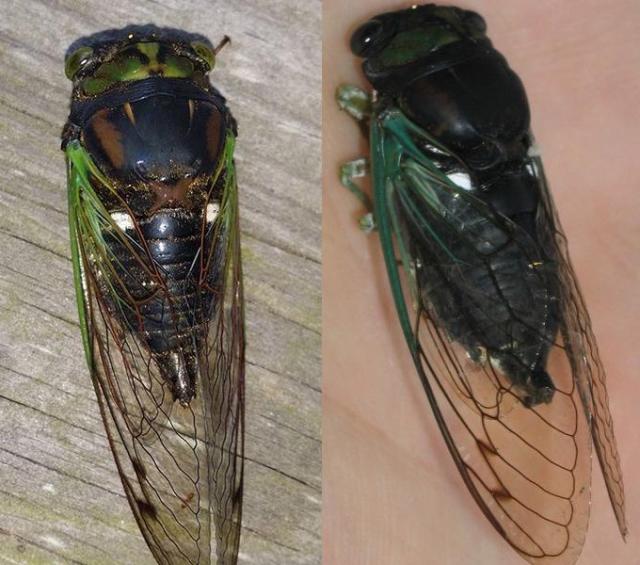
The cicada on the Left was found in Middletown NJ, and the cicada on the Right in Metuchen, NJ. Middletown is closer to the ocean than Metuchen is, but both share a similar elevation and vegetation.
It is interesting to note the color variation found in Neotibicen tibicen tibicen aka chloromera aka Swamp Cicada aka Hunch-Back cicada.
In some areas the dorsal side of N. tibicen tibicen can be almost all black, while in other locations their pronotums & mesonotums feature vibrant greens & rusty browns — you can even make out the “M” on the mesonotum.
There may have been cross breeding between the Southern Swamp Cicada (Neotibicen tibicen australis), at some point in time, providing some Neotibicen tibicen tibicen with more colorful appearance. Read Intergrade zones with australis on BudGuide for more information on that possibility.
This female Neotibicen lyricen engelhardti aka Dark Lyric Cicada was found during my lunch (half) hour in Middletown, NJ (95ft elevation). Yes it is covered with ants.
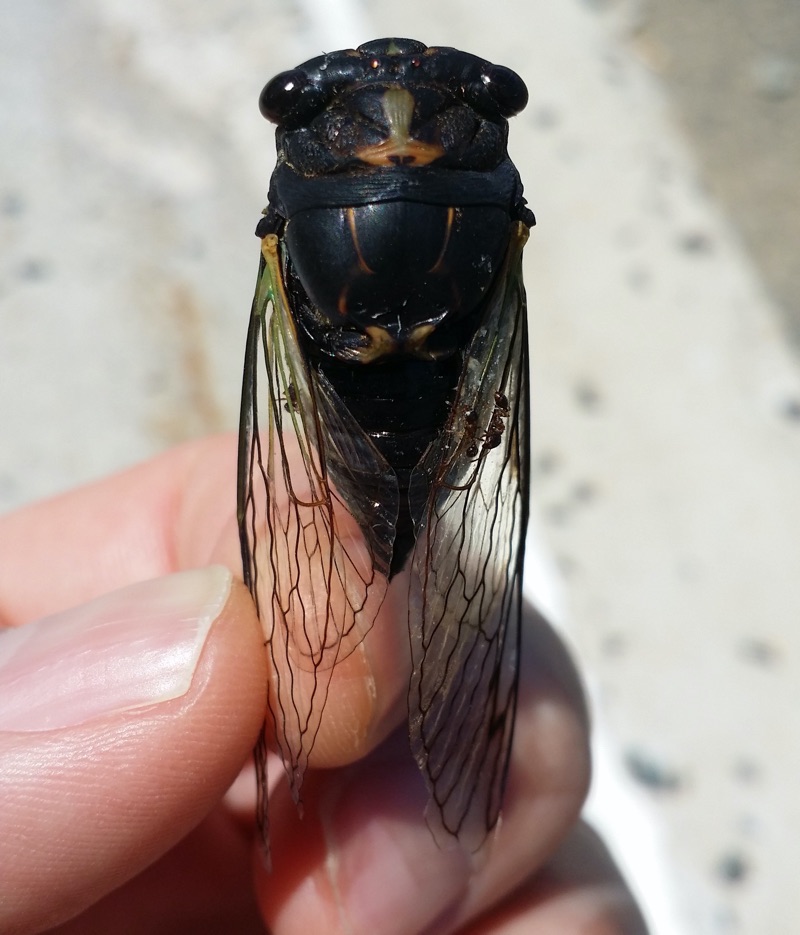
More information about N. lyricen engelhardti.
The Tibicen bermudiana Verrill (T. bermudianus) if you want the genus and species names to agree, and maybe now Neotibicen bermudianus) is a cicada that was endemic to Bermuda and is now extinct. Its closest relative is the Tibicen lyricen, which is found in the United States (and not extinct).
Here is a photo of a T. bermudiana from the collection found at the Staten Island Museum:
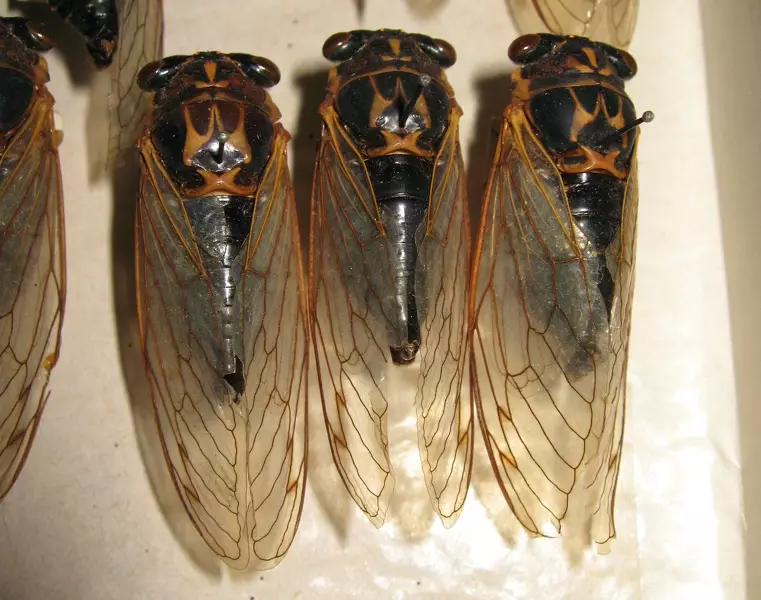
More photos by Roy Troutman, click for larger versions:
From the Bermuda’s Fauna website:
Sadly, when most of the Bermuda cedar trees were killed of by a blight in the 1950s, the cicadas that made the nights so uniquely magical and romantic in sound also largely disappeared.
Updated with a photo of the coin commemorating this cicada:
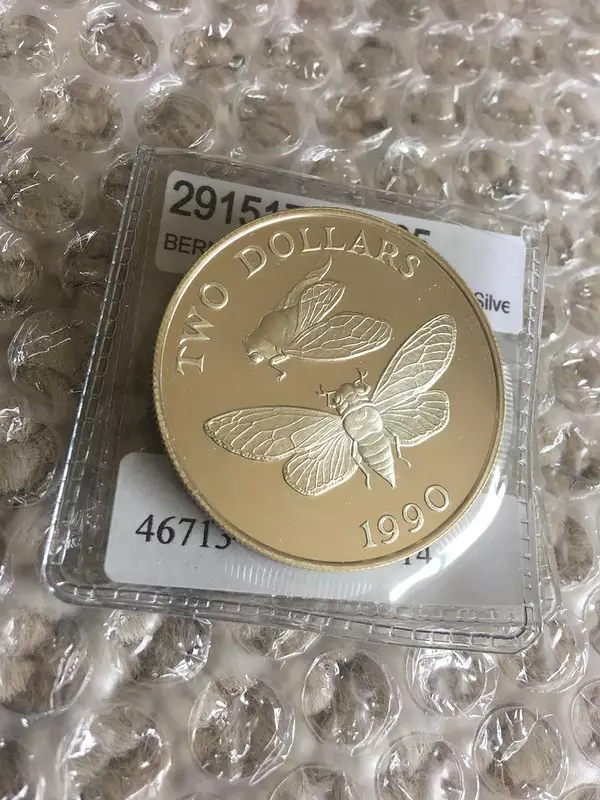
Tonight I went to Manchester, New Jersey to look and listen for Neotibicen auletes aka the Northern Dusk-Singing cicada. As the name suggests, these cicadas sing at dusk (basically right at sunset). They are also the largest cicadas in North America.
I heard many auletes, found some nymphal skins, and one dead adult. Unfortunately I found no live specimens to film or video. Next time.

* Note as of 2023 the name of this cicada has changed to Megatibicen grossus. You can also call it a Northern Dusk-Signing Cicada.
Elias Bonaros shared this photo of a Neocicada hieroglyphica that he observed emerging in Riverhead, Long Island, New York, which is the north-most point of their range, as documented by William T. Davis.
They were taken today, July 13th, 2015.
Here is the Neocicada hieroglyphica hieroglyphica exiting its nymphal skin.


Annette DeGiovine wrote an extensive blog post with many images and video of emerging Neocicada hieroglyphica. Check it out.
People ask: why do periodical cicadas stay underground for 17 or 13 years?
There are three parts to this puzzle that people are interested in:
Cicadas likely don’t count like people do (“1,2,3,4…”) and you won’t find scratch marks inside the cell (where they live underground) of a Magicicada, marking off the years as they go by. However, there is a kind of counting going on, and a good paper to read on that topic is How 17-year cicadas keep track of time by Richard Karban, Carrie A. Black, and Steven A. Weinbaum. (Ecology Letters, (2000) Q : 253-256). By altering the seasonal cycles of trees they were able to make Magicicada emerge early, proving that cicadas “count” seasonal cycles, perhaps by monitoring the flow and quality of xylem sap, and not the passage of real time.
Why prime numbers, and why is the life cycle so long? This topic fascinates people. The general consensus is that the long, prime-numbered life-cycle makes it difficult for an above-ground animal predator to evolve to specifically predate them. Read Emergence of Prime Numbers as the Result of Evolutionary Strategy by Paulo R. A. Campos, Viviane M. de Oliveira, Ronaldo Giro, and Douglas S. Galva ̃o (PhysRevLett.93.098107) for more on this topic. An argument against that theory is that a fungus, Massospora cicadina, has evolved to attack periodical cicadas regardless of their life cycle. Of course, a fungus is not an animal. Maths are easy for fungi.
There are also questions about why there are 13 and 17 year life cycles, why a 4 year acceleration of a brood might occur1 and why Magicicada straggle.
1 This is a good place to start: Genetic Evidence For Assortative Mating Between 13-Year Cicadas And Sympatric”17-Year Cicadas With 13-Year Life Cycles” Provides Support For Allochronic Speciation by Chris Simon, et al, Evolution, 54(4), 2000, pp. 1326—1336.
Sometimes you wake up and the whole world is different. See this cicada:
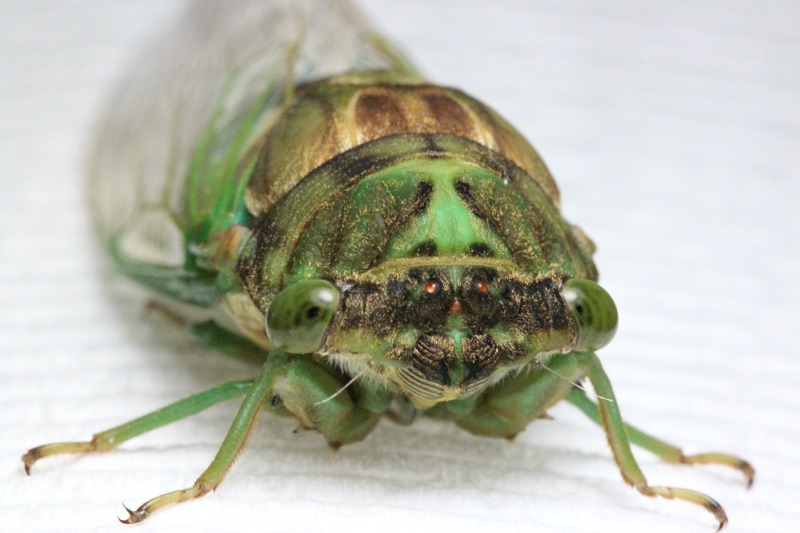
photo by me.
… when I went to sleep she was a Tibicen tibicen tibicen, but now I know she is a Neotibicen tibicen tibicen. 10 years ago, she was a Tibicen chloromera. 130 years ago, she was Cicada tibicen. Cicada names change as researchers discover their differences.
Two new papers have split the Tibicen (or Lyristes) genera into many genera: Tibicen (European Tibicen), Auritibicen (Tibicen of Asia/Japan), Neotibicen (mostly eastern North American Tibicen), and Hadoa (Tibicen of the western United States).
The first paper is Description of a new genus, Auritibicen gen. nov., of Cryptotympanini (Hemiptera: Cicadidae) with redescriptions of Auritibicen pekinensis (Haupt, 1924) comb. nov. and Auritibicen slocumi (Chen, 1943) comb. nov. from China and a key to the species of Auritibicen by Young June Lee, 2015, Zootaxa 3980 (2): 241—254. This paper establishes the new genera Auritibicen, and the members of the Tibicen/Lyristes genera fall into that genera. Here is a link. So, Tibicen flammatus aka Lyristes flammatus of Japan, for example, becomes Auritibicen flammatus.
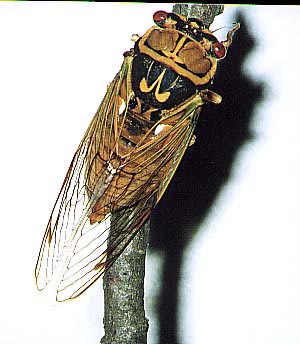
Auritibicen flammatus photo by Osamu Hikino.
The second paper is Molecular phylogenetics, diversification, and systematics of Tibicen Latreille 1825 and allied cicadas of the tribe Cryptotympanini, with three new genera and emphasis on species from the USA and Canada (Hemiptera: Auchenorrhyncha: Cicadidae) by Kathy B. R. Hill, David C. Marshall, Maxwell S. Moulds & Chris Simon. 2015, Zootaxa 3985 (2): 219—251. This paper establishes the Neotibicen (Hill and Moulds), and Hadoa (Moulds) genera. This paper also sought to establish the Subsolanus genera for the Asian Tibicen/Lyristes species but the previously mentioned paper by Young June Lee has precedence because it was published first. Link to paper.
To recap, European Tibicen/Lyristes are Tibicen…
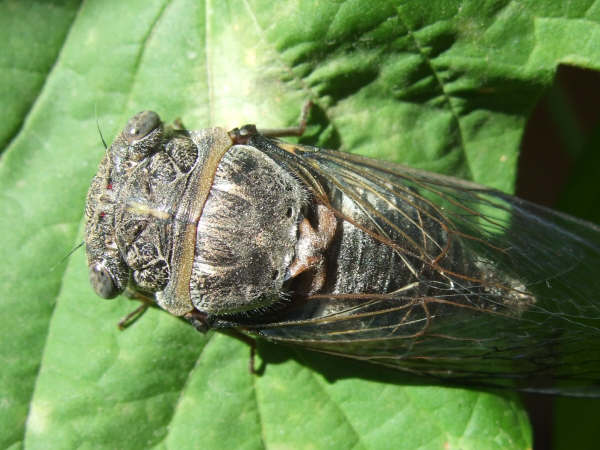
Tibicen plebejus photo by Iván Jesus Torresano García.
… Asian Tibicen/Lyristes are now Auritibicen. Mostly-eastern North American Tibicen are now Neotibicen, and Western North American Tibicen are now Hadoa. Note that, the catagorization is not due to location, but to genetic and physiological evaluation (read the papers).
Needless to say this website and others have a lot of name changing to do, but in the mean time, here’s where the North American species fall out:
| Neotibicen | |
|---|---|
| Tibicen auletes | Neotibicen auletes |
| Tibicen auriferus | Neotibicen auriferus |
| Tibicen canicularis | Neotibicen canicularis |
| Tibicen cultriformis | Neotibicen cultriformis |
| Tibicen davisi davisi | Neotibicen davisi davisi |
| Tibicen davisi harnedi | Neotibicen davisi harnedi |
| Tibicen dealbatus | Neotibicen dealbatus |
| Tibicen dorsatus | Neotibicen dorsatus |
| Tibicen figuratus | Neotibicen figuratus |
| Tibicen latifasciatus | Neotibicen latifasciatus |
| Tibicen linnei | Neotibicen linnei |
| Tibicen lyricen engelhardti | Neotibicen lyricen engelhardti |
| Tibicen lyricen lyricen | Neotibicen lyricen lyricen |
| Tibicen lyricen virescens | Neotibicen lyricen virescens |
| Tibicen pronotalis pronotalis | Neotibicen pronotalis pronotalis |
| Tibicen pronotalis walkeri | Neotibicen pronotalis walkeri |
| Tibicen pruinosus fulvus | Neotibicen pruinosus fulvus |
| Tibicen pruinosus pruinosus | Neotibicen pruinosus pruinosus |
| Tibicen resh | Neotibicen resh |
| Tibicen resonans | Neotibicen resonans |
| Tibicen robinsonianus | Neotibicen robinsonianus |
| Tibicen similaris | Neotibicen similaris |
| Tibicen superbus | Neotibicen superbus |
| Tibicen tibicen australis | Neotibicen tibicen australis |
| Tibicen tibicen tibicen | Neotibicen tibicen tibicen |
| Tibicen tremulus | Neotibicen tremulus |
| Tibicen winnemanna | Neotibicen winnemanna |
| Hadoa | |
| Tibicen bifidus | Hadoa bifida |
| Tibicen chiricahua | Hadoa chiricahua |
| Tibicen duryi | Hadoa duryi |
| Tibicen inauditus | Hadoa inaudita |
| Tibicen longioperculus | Hadoa longiopercula |
| Tibicen neomexicensis | Hadoa neomexicensis |
| Tibicen parallelus | Hadoa parallela |
| Tibicen simplex | Hadoa simplex |
| Tibicen texanus | Hadoa texana |
| Tibicen townsendii | Hadoa townsendii |
It is important to note that when we talk about cicada broods, we are talking about the 17 & 13-year periodical Magicicada cicadas. We are not talking about Tibicen or other species.
There are 12 groups of Magicicadas with 17-year life cycles and 3 groups of Magicicadas with 13-year life cycles. Each of these groups emerge in a specific series of years, rarely overlapping (17 & 13-year groups co-emerge every 221 years, for example). Each of these groups emerge in the same geographic area their parents emerged. These groups, each assigned a specific Roman numeral, are called broods.
Gene Kritsky’s book, Periodical Cicadas: The Plague and the Puzzle, documents the history of the recognition and naming of the broods. The first person to document that different groups of periodical cicadas emerged in different years was Nathaniel Potter in 1839. Benjamin D. Walsh and Charles V. Riley devised the system for numbering the different broods in 1868, and then C. L. Marlatt sorted the 17 year broods out from the 13-year broods, giving us the system we have today.
Visit our Broods page which features a grid of the Brood names, their lifespan, when & where they’ll emerge next and links to maps.
Is it true that someone has offered a reward for a white or blue-eyed Magicicada cicadas?
This was false and an urban legend until in 2008 when Roy Troutman began to offer rewards for living blue-eyed cicadas for scientific research. All cicadas were released, unharmed.
Important: Roy is no longer offering the reward as he has obtained the cicadas needed for his research. So, don’t bug him, unless you want to tell him that his photos and video are awesome.
White or Blue-eyed Magicicadas cicadas are extremely rare, so finding them can be difficult. I usually find one per emergence, and that is after looking at thousands of cicadas.
Speaking of Roy and White-eyed cicadas, here is a video Roy took of a White-eyed cicada:
And here’s a white and orange-eyed cicada photo taken by Roy:
